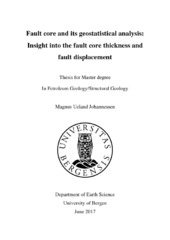Fault core and its geostatistical analysis: Insight into the fault core thickness and fault displacement
Master thesis
Permanent lenke
https://hdl.handle.net/1956/16394Utgivelsesdato
2017-06-23Metadata
Vis full innførselSamlinger
- Department of Earth Science [1050]
Sammendrag
Fault core is a high-strain zone of a fault, which accommodate intense deformation. Due to high strain, complex structures and intensely deformed fault rocks form in the fault core, which again affects the geometry and lateral variations in fault core thickness. From a reservoir perspective, the complexity and variations in fault core thickness may affect fluid flow across the faults. The sub-seismic size of the fault core makes it not detectable on seismic data, so a scaling relationship between the core thickness and displacement needs to be investigated, as well as the variations and complexity of the fault core, based on outcrop studies. This Master thesis documents and quantifies the lateral variations in fault core thickness along different levels of the fault height, and examines factors affecting the thickness variations. Measurements of the fault core thickness and displacement have been performed in siliciclastic rocks and carbonates, to study the lithological effects on the fault attributes. The collected dataset have further been univariately analyzed, and exceedence frequency plots have been constructed to recognize the distribution trends. Statistical analysis was then performed to investigate the fault core thickness-displacement relationship and state the scaling relationship between the two fault attributes. The relationship has been examined using measurements of the fault core thickness and displacement from the exact same levels along the fault height, and from average measurements. One of the factors controlling the fault core thickness is lithology and the competency contrasts of the faulted lithologies. The competency contrast leads to significant variations in core thickness, and measurements from this project show that faults juxtaposing heterogeneous sequences display a much wider fault core, compared to faults juxtaposing homogeneous sequences. Another factor affecting the variation in core thickness are the type of fault rocks situated in the fault core. Host rock lenses incorporated in the fault core have been observed and measured to increase the fault core and the internal core complexity. The measurements in this thesis also show that minor faults in carbonates generally exposes a wider fault core, compared to fault cores in siliciclastic rocks. The variations in fault core thickness in different lithologies are controlled by an interplay of factors, such as fault geometry, interactions between the surrounding faults, tectonic regimes and competency contrasts. Analysis of a global dataset, including new data gathered in this thesis and the results from previously published studies, shows that fault core thickness and displacement follow an overall power-law or-log-normal for univariate distribution. Bivariate analysis of the relationship for the global dataset, reveals a strong power-law relationship, with a correlation coefficient of 0.7390. However, when the global dataset is sorted based on the faulted lithology, a stronger relationship (with higher correlation coefficient) can be found. When measurements from this thesis are included in the lithological based dataset, the measurements contributes to a minor increase in the regression value. This suggests that when handling such data, we need to differentiate between rocks of different lithologies.
Utgiver
The University of BergenOpphavsrett
Copyright the Author. All rights reservedBeslektede innførsler
Viser innførsler beslektet ved tittel, forfatter og emneord.
-
Structure and flow properties of syn-rift border faults: The interplaybetween fault damage and fault-related chemical alteration (Dombjerg Fault, Wollaston Forland, NE Greenland)
Kristensen, Thomas Berg; Rotevatn, Atle; Henstra, Gijs Allard; Peacock, David; Midtkandal, Ivar; Grundvåg, Sten-Andreas (Peer reviewed; Journal article, 2016-11)Structurally controlled, syn-rift, clastic depocentres are of economic interest as hydrocarbon reservoirs; understanding the structure of their bounding faults is of great relevance, e.g. in the assessment of fault-controlled ... -
Normal fault growth and fault zone architecture of normal faults exposed in the Corinth Canal, central Greece
Sletten, Stine Hemnes (Master thesis, 2016-08-22)The Corinth Canal in central Greece consists of an excellent natural transect across a population of normal faults. This study presents a structural analysis of 23 exposed faults, focusing on fault geometry, fault zone ... -
Faults architecture and their scaling relationships: Insights into fault core thickness and fault displacement
Seifried, Donald Tracy (Master thesis, 2012-10-01)The purpose of this study is to investigate the statistical characteristics of fault core thickness and fault displacement, and to state the relationship between these two fault attributes. Field work was carried out At ...
